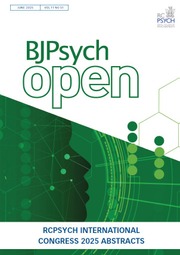Crossref Citations
This article has been cited by the following publications. This list is generated based on data provided by
Crossref.
Tracy, Derek K.
Joyce, Dan W.
and
Shergill, Sukhwinder S.
2016.
Kaleidoscope.
British Journal of Psychiatry,
Vol. 208,
Issue. 1,
p.
98.
Foreman, David
2016.
Should early intervention in autism be provided?.
BJPsych Advances,
Vol. 22,
Issue. 3,
p.
147.
Sarraf, Matthew Alexandar
and
Woodley of Menie, Michael Anthony
2017.
Of Mice and Men: Empirical Support for the Population-Based Social Epistasis Amplification Model (a Comment on ).
eneuro,
Vol. 4,
Issue. 5,
p.
ENEURO.0280-17.2017.
Frauenberger, Christopher
Makhaeva, Julia
and
Spiel, Katta
2017.
Interaction Design and Autistic Children.
p.
743.
Hebron, Judith
and
Bond, Caroline
2017.
Developing mainstream resource provision for pupils with autism spectrum disorder: parent and pupil perceptions.
European Journal of Special Needs Education,
Vol. 32,
Issue. 4,
p.
556.
Golding, Jean
Ellis, Genette
Gregory, Steven
Birmingham, Karen
Iles-Caven, Yasmin
Rai, Dheeraj
and
Pembrey, Marcus
2017.
Grand-maternal smoking in pregnancy and grandchild’s autistic traits and diagnosed autism.
Scientific Reports,
Vol. 7,
Issue. 1,
Spiel, Katta
Frauenberger, Christopher
Hornecker, Eva
and
Fitzpatrick, Geraldine
2017.
When Empathy Is Not Enough.
p.
2853.
Spiel, Katta
Malinverni, Laura
Good, Judith
and
Frauenberger, Christopher
2017.
Participatory Evaluation with Autistic Children.
p.
5755.
Morales-Hidalgo, Paula
Roigé-Castellví, Joana
Hernández-Martínez, Carmen
Voltas, Núria
and
Canals, Josefa
2018.
Prevalence and Characteristics of Autism Spectrum Disorder Among Spanish School-Age Children.
Journal of Autism and Developmental Disorders,
Vol. 48,
Issue. 9,
p.
3176.
Petrou, Alexandra M.
Parr, Jeremy R.
and
McConachie, Helen
2018.
Gender differences in parent-reported age at diagnosis of children with autism spectrum disorder.
Research in Autism Spectrum Disorders,
Vol. 50,
Issue. ,
p.
32.
Bachmann, Christian J
Gerste, Bettina
and
Hoffmann, Falk
2018.
Diagnoses of autism spectrum disorders in Germany: Time trends in administrative prevalence and diagnostic stability.
Autism,
Vol. 22,
Issue. 3,
p.
283.
Bennett, Matthew
Webster, Amanda A.
Goodall, Emma
and
Rowland, Susannah
2018.
Life on the Autism Spectrum.
p.
17.
McWilliams, Andrew
Reilly, Colin
Gupta, Jaya
Hadji-Michael, Maria
Srinivasan, Ramya
and
Heyman, Isobel
2019.
Autism spectrum disorder in children and young people with non-epileptic seizures.
Seizure,
Vol. 73,
Issue. ,
p.
51.
McDowell, Michael
and
Lesslie, Jane
2019.
Neurodevelopmental–behavioural paediatrics.
Current Opinion in Pediatrics,
Vol. 31,
Issue. 6,
p.
797.
Kilburn, Tina R.
Juul Sørensen, Merete
Thastum, Mikael
Rapee, Ronald M.
Rask, Charlotte Ulrikka
Bech Arendt, Kristian
and
Thomsen, Per Hove
2019.
Group-based Cognitive Behavioural Therapy for Anxiety Disorder in Children with Autism Spectrum Disorder: a feasibility study.
Nordic Journal of Psychiatry,
Vol. 73,
Issue. 4-5,
p.
273.
McConkey, Roy
2020.
The increasing prevalence of school pupils with ASD: insights from Northern Ireland.
European Journal of Special Needs Education,
Vol. 35,
Issue. 3,
p.
414.
Syme, Kristen L.
and
Hagen, Edward H.
2020.
Mental health is biological health: Why tackling “diseases of the mind” is an imperative for biological anthropology in the 21st century.
American Journal of Physical Anthropology,
Vol. 171,
Issue. S70,
p.
87.
Hayes, Jennie
McCabe, Rose
Ford, Tamsin
and
Russell, Ginny
2020.
Drawing a line in the sand: affect and testimony in autism assessment teams in the UK.
Sociology of Health & Illness,
Vol. 42,
Issue. 4,
p.
825.
Toseeb, Umar
McChesney, Gillian
Oldfield, Jeremy
and
Wolke, Dieter
2020.
Sibling Bullying in Middle Childhood is Associated with Psychosocial Difficulties in Early Adolescence: The Case of Individuals with Autism Spectrum Disorder.
Journal of Autism and Developmental Disorders,
Vol. 50,
Issue. 5,
p.
1457.
Sala, Regina
Amet, Lorene
Blagojevic-Stokic, Natasa
Shattock, Paul
and
Whiteley, Paul
2020.
<p>Bridging the Gap Between Physical Health and Autism Spectrum Disorder</p>.
Neuropsychiatric Disease and Treatment,
Vol. Volume 16,
Issue. ,
p.
1605.


eLetters
No eLetters have been published for this article.